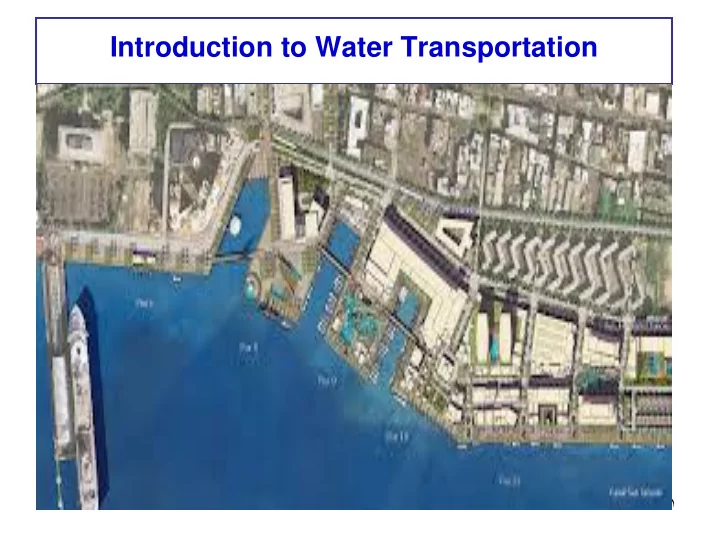

Introduction to Water Transportation 1
- Egyptians had ships 6000 B.C. - Recently, increase in use is attributed to growing population, new products and new sources of raw materials ,…etc - A need for most modern and efficient port facilities - 99% of overseas freight tonnage is transported by ships. 2
Nature of water transportation • Suitable for heavy commodities • For long distances • Where time of transport is not a critical factor 3
Principal classes of service for shipping industry 1. Liner service: Predetermined schedules between specific ports. 2. Non-Liner service: No schedules, chartering and special voyages. 3. Tanker service: for the carriage of liquid cargo.
Passenger Ships Few passenger ships remain in service due its low speeds compared with other modes of transportation. Types: 1. Passenger ferries. (for short distances) 2. Cruising ships. (for recreation)
General Cargo ships: Trend is increasing the size and the speed. Bulk Carriers: Used for carrying the ore and coal. Tankers: - Liquid cargo ( oil, asphalt, gasoline, chemicals, ....)
Special Ships: • Container ships: carries containers with standard sizes (ex: 8 x 8 x 20 ft) • Barge carrying ships: carries its loading and unloading equipment. • Roll on - Roll off ships: carries loaded pickups and trucks.
8
Ships Characteristics 1- Dimensions: Length: governs the length and layout of the sea port terminal Beam: governs the width of channels and basins, & cargo handling equipment Draft: governs the depths of channels, basins, and ports 9
2. Cargo carrying capacity 3. Cargo handling (crane, pumps) 4. Types of cargo 5. Shape 6. Mooring equipment 7. Maneuverability 10
Design of Harbors Port: used for commercial activities Harbor: partially enclosed water area to protect ships from waves and winds and to control the erosion of the beach 11
12
Environmental Considerations: protection should be provided against biological (termites attack wood) and chemical (rust of steel) factors Winds: cause horizontal forces on all structures above water level Waves: cause horizontal forces on all structures at the boundaries of the port 13
Current : similar to waves but has lower speed Tide: rising & falling of water surface (caused by the gravitational attractions of the moon & the sun) 14
Classes of Harbors According to Structures: 1. Natural: formed in bays and inlets 2. Artificial: using artificial structures According to Uses: 1. Commercial: for trade 2. Military: navy 15
Desirable Features of A Harbor Site 1. Sufficient depth (21 – 37 ft up to 94 ft for tankers) 2. Secure anchorage 3. Adequate anchorage area 4. Narrow channel entrance: width = length of largest ship 5. Protection against wave action 6. Good soil conditions (firm & cohesive along the bottom of the anchorage area) 16
Shape and Size of Anchorage Area Depend on 1. Maximum number of ships to be served 2. Ship sizes 3. Mooring method (single or two anchors) 4. Maneuverability requirements: radius = ship length 5. Topographic condition at the proposed site Rule of Thump: 17 Width of entrance = length of largest ship
Protective costal works 1. Offshore structures (breakwaters) to lessen wave heights and velocities 2. Structures that are built at an angle to the shore, such as jetties and groins to control littoral drift 3. Structures built at or near the shoreline to protect the shore from erosive forces of waves. 4. Natural costal features such as protective beaches to help controlling and dissipating waves without creating adverse environmental effects 18
Breakwaters and Jetties Breakwaters: built parallel to the shorelines to protect the shore area from waves Jetties: built perpendicular to the shoreline to maintain a protected entrance channel 19
Breakwater 20 Jetty
Breakwater Types: 1. Rubble mound (large stones): natural or artificial (concrete units) 2. Wall breakwaters, made of: a. Timber cribs filled with large stones b. Concrete caissons filled with sand or stones c. Sheet piling 3. Composite (both 1 and 2) 21
Port Planning • The planning and size of port begins with an appraisal of present and future commerce types of shipping • Estimate of number, type, and size of ships t be accommodated • Estimating capacity of port, tons/year/terminal 22
• Ships arrive at a public port in accordance with a random pattern • Poisson distribution may be used to predict the number of days on which a particular number of ships will be present 23
24
The annual port capacity Q in tons is given by the following equation: 25
Recommend
More recommend